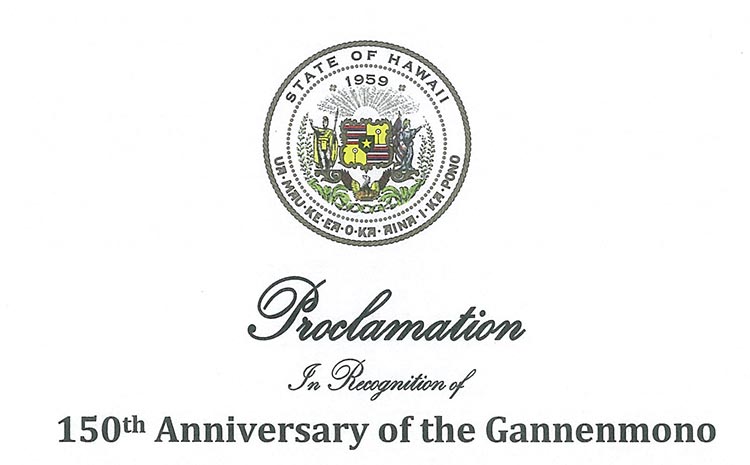Proclomation
In recognition of
150TH ANNIVERSARY OF THE GANNENMONO
WHEREAS, the first group of Japanese immigrants to Hawai’i were referred to as gannenmono, “people of the first
year,” because they came to Hawai’i in Meiji Gannen, the first year in the reign of Emperor Meiji of Japan; and
WHEREAS, the gannenmono left Yokohama, Japan on May 17, 1868, on the Scioto with courage, determination, dreams
and hopes of a better life, and their perseverance, sacrifice and hard work helped shape Hawai’i’s diverse landscape
today; and
WHEREAS, the gannenmono, which included tailors, barbers, cooks, potters, even a former samurai, were recruited to
work on sugarcane plantations; and
WHEREAS, 148 gannenmono arrived in Hawai’i on June 19, 1868, among whom were six women and two children; and
WHEREAS, the gannenmono were hired by various employers or plantation owners and dispersed throughout the
Hawaiian Islands — 71 sent to Maui, 51 to Oahu, and 22 to Kaua’i; and
WHEREAS, some gannenmono moved to the mainland after contracts ended; some returned home to Japan; and about
50 remained in the islands, choosing to start a new life, marrying Hawaiian women, learning the native language, and
laying the foundation for Japanese immigrants in later years; and
WHEREAS, in 1968, many memorials were placed in the Hawaiian Islands to commemorate the centennial of the
gannenmono — memorial plaques at the Honolulu International Airport, a Buddha statue at Foster Botanical Garden, a
five-storied stone pagoda in Honolulu, a stone Buddha in Lahaina, stone lanterns at the Lili’uokalani Gardens in Hilo,
and the Byodo-In Temple was built in Kane’ohe; and
WHEREAS, the 150th commemoration is organized by Kizuna Hawai’i, a consortium of 20 organizations, along with the
Association of Nikkei & Japanese Abroad and the Consulate General of Japan in Honolulu, to celebrate and perpetuate
the history of Japanese-Americans in Hawai’i and foster friendship between Hawai’i and Japan; and
WHEREAS, l5Oth commemoration events include the 59th Convention of Nikkei & Japanese Abroad, symposium,
exhibits at Bishop Museum and the Japanese Cultural Center of Hawai’i, and a visit by Prince Fumihito and Princess
Kiko of Japan;
THEREFORE I, DAVID Y. IGE, Governor, and I, DOUGLAS S. CHIN, Lieutenant Governor of the State of Hawai’i, do
hereby recognize 2018 as the
“150TH ANNIVERSARY OF THE GANNENMONO”
in Hawai’i and ask the people of the Aloha State to join us in celebrating this auspicious occasion and recognizing the
cultural legacy of the gannenmono, a true and compelling story of inspiration.
Done at the State Capitol, in Executive Chambers, Honolulu, State of Hawai’i, this thirtieth day of May 2018.

